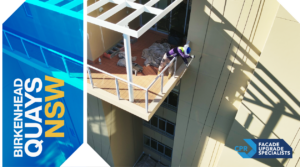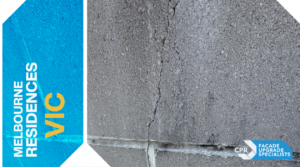Diagnosing and addressing concrete cancer isn’t just another tick-box maintenance task – for Sydney’s strata committees, it’s a high-stakes balancing act involving resident safety, long-term asset value, structural integrity, and mounting project costs. This isn’t new-build territory, and it’s not the reactive world of emergency patch jobs either. This is remedial work – a specialised discipline that requires transparency, compliance, and expert coordination across the board.
In Sydney, an increasing number of buildings – particularly those over 10 years old – are reporting signs of concrete spalling. These visible symptoms often indicate the presence of concrete cancer, a deeper, more corrosive issue that can jeopardise the structural stability of an entire building. And with strata levies already stretched, insurance costs on the rise, and compliance pressures mounting, there’s simply no room for misdiagnosis, delay, or ineffective quick fixes.
How to Identify Concrete Cancer
Concrete cancer develops when moisture infiltrates reinforced concrete and begins to corrode the embedded steel. As the steel rusts and expands, it exerts internal pressure, cracking the surrounding concrete and causing it to break off – this is what’s referred to as “spalling.”
Common indicators include:
- Rust-coloured stains running down walls or emerging from ceiling cracks
- Flaking, crumbling, or cracking sections of concrete
- Paint or render that bubbles, lifts or peels away
- Visible steel reinforcement that appears rusted or exposed
Early diagnosis is essential. Using rope access and grid-mapping, our team creates a detailed inspection plan that breaks the entire façade into drop zones. Every defect is documented by location, type, and severity – eliminating guesswork and helping strata committees make informed decisions with confidence.
Worried your strata building may be suffering from concrete cancer?
Book a certified inspection with CPR’s Scaffold-Free™ specialists and gain clarity before costs spiral out of control. Schedule your assessment now
Concrete Cancer in Sydney Strata: What’s Driving It?

- Coastal Air: High salt content in Sydney’s coastal atmosphere accelerates steel corrosion.
- Building Age: Many high-rise strata buildings built in the 1970s–1990s are reaching critical structural milestones.
- Historical Defects: Past shortcuts in concrete cover, waterproofing, and patchwork repairs are now revealing their true cost.
- Lack of Preventative Maintenance: Without routine inspections, minor defects can escalate into costly structural issues.
We work directly with committees to provide detailed, evidence-based repair scopes. No templated reports. No inflated budgets. Just clear findings and real-world solutions.
Concrete Repair Sydney Strata: What to Expect
Once concrete cancer is confirmed, CPR develops a targeted repair strategy tailored to your building’s needs:
- Drop-by-drop, grid-based repair scope
- Exact material specification and seamless aesthetic matching
- Work executed from our dust-controlled, enclosed SkyPod® system
- Whisper-quiet, non-invasive execution with no unit access required
Our clients receive photo documentation before and after each patch repair – organised by drop, floor, and defect type – as part of your digital project record.
Strata Committee Responsibilities & Concrete Spalling
NSW strata legislation requires committees to maintain and repair common property. This includes anything affecting structural soundness – such as concrete cancer. Ignoring symptoms not only increases repair costs but may result in regulatory breaches or legal claims if injuries or damages occur.
Partnering with CPR helps strata managers and committees:
- Identify issues early with certified inspections
- Plan financially with accurate project scopes and forecasting
- Save time and money using Scaffold-Free™ remediation
- Meet legal obligations under the DBP Act
FAQs
How long does a concrete cancer diagnosis take? It varies, but most Sydney buildings can be thoroughly assessed within 2–5 working days depending on complexity and height.
Do residents need to vacate units or balconies? No. All works are performed externally using our proprietary rope and pod systems. There is minimal noise and no unit access required.
Can we get an estimate before the diagnostic phase? We can provide a ballpark figure, but formal quotes are only accurate after a detailed grid-based inspection.
We already had someone inspect it – do we still need CPR? Unless your previous inspection was performed by a DBP-registered practitioner, it may not meet current compliance standards. We can review and advise accordingly.
Does insurance cover this sort of damage? Some strata insurance policies offer partial coverage for concrete cancer, especially if the committee has a proactive maintenance history. We can assist in supporting your claims.
The DBP Act: What It Means for You
Since mid-2020, the Design and Building Practitioners (DBP) Act has reshaped how strata works are conducted in NSW. For Class 2 buildings – such as apartments and residential complexes – all works involving structural or waterproofing elements must be planned and executed by registered professionals. That means generic builder reports or unregistered handyman work no longer meet the legal threshold.
That’s where CPR excels. Our internal team includes fully registered Design Practitioners and Building Practitioners. We own the entire process – from initial inspection to registration of design intent, certification, rope-based access setup, execution, and final client walkthrough. No subcontractor maze. No missed details. Just one expert team managing the job from start to finish.
Why CPR?
We’re not just repairers, our building restoration services, we’re your scaffold-free remediation partner, built for access-challenged buildings and urgent needs.
- Fully compliant with National Construction Code (NCC) and all applicable Australian Standards
- Fully licensed, fully insured, and exclusively staffed with trade-qualified professionals
- Specialist diagnostic systems including SFS360® and SE2EPC® for 360° reporting
- Crystal-clear communication and photographic proof of every repair
- Disruption-free, rope-based works via MARS™, PEARS® and our patented SkyPod® system
Our proprietary technologies and processes allow us to deliver top-tier remedial works without compromising your residents’ privacy or safety.
Take Action Now – Don’t Let Concrete Cancer Spread
Concrete deterioration only gets worse – and more expensive – over time. Don’t wait for visible cracks to become safety risks.
Partner with CPR and get Sydney’s leading Scaffold-Free™ remediation experts on the case.






